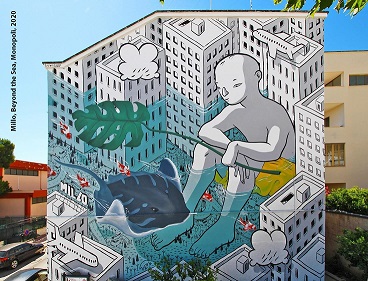Mimetic Mechanisms and Indigenous Vulnerability in Alexis Wright’s Carpentaria
DOI:
https://doi.org/10.54103/2035-7680/18694Parole chiave:
Carpentaria; Alexis Wright; vulnerability; mimetic theory; scapegoatingAbstract
This article investigates Alexis Wright’s novel Carpentaria (2006) through the lens of the mimetic theory developed by René Girard, which I combined with Jean Price-Mars’ definition of “collective bovarism” and Umberto Eco’s narrative semiotics. In my close reading of the novel, I explore how the author exposes the detrimental mimetic mechanisms hidden behind characters’ behaviours and relationships to articulate a discourse on the risks of assimilation and the necessity for Aboriginal resistance to neocolonialism. I argue that in Carpentaria the emulation of the dominant society’s values and beliefs by assimilated Indigenous characters results in the social disintegration and vulnerability of the Indigenous communities. Not only do mimetic mechanisms negatively affect the epistemic systems of Aboriginal characters in terms of preparedness to climate change, but they also undermine their social cohesion and physical survival. Furthermore, investigating the text at a semiotic level, I identified some thematic isotopies that Wright uses to emphasise the racial bias and dehumanising attitudes towards black people embedded in the neocolonial gaze. Prioritising the textual dimension of the novel, my approach focuses on how the sociocultural and physical vulnerability of the Indigenous characters is depicted at a philosophical, rhetorical and narratological level. My investigation focuses on four narrative places: the dump, the city, the Pricklebush and the ocean.
Metriche
Riferimenti bibliografici
Ashcroft, Bill, et al. Postcolonial Studies. The Key Concepts. Routledge, 2013.
Concilio, Carmen. “Waste Lands and Human Waste in Postcolonial Texts. Alexis Wright’s Carpentaria and Katherine Boo’s Behind the Beautiful Forevers.” Anglistica AION, vol. 19, no. 2, 2015, pp. 21-35. http://hdl.handle.net/2318/1632444. Accessed 15 Jul. 2021.
Broome, Richard. Aboriginal Australians: A history since 1788. Allen & Unwin, 1982.
De Gaultier, Jules. Le Bovarysme. Mercure de France, 1921.
Eco, Umberto. “The Problems in Textual Interpretation.” Poetics Today, vol. 2, no. 1a, Autumn 1980, pp. 145-161.
Girard, René. Deceit, Desire, the Novel: Self and Other in Literary Structure. Johns Hopkins Press, 1965.
---. The Scapegoat. Johns Hopkins Press, 1986.
Hall, Demelza. “The Isle of Refuse in Alexis Wright’s Carpentaria: Reconstructing Heterotopic Space.” Southerly, vol. 72, no. 3, 2013, pp. 12-26. https://www.academia.edu/3823178/The_Isle_of_Refuse_in_Alexis_Wright_s_Carpentaria_Reconstituting_Heterotopic_Space. Accessed 10 Jul. 2021.
Hanish, Marvin. The Stolen Generations: Critical Reflections on the Forced Removals of Semi-Indigenous Children in Western Australia from 1900 until Today. GRIN Verlag, 2011.
Hasluc, Paul. Native Welfare Conference, Commonwealth of Australia, Parliamentary Debates, House of Representatives, 20 April 1961, p. 1051. http://historichansard.net/hofreps/1961/19610420_reps_23_hor30/. Accessed 10 Jul. 2021.
Joseph, Laura. “Dreaming Phantoms and Golems: Elements of the Place Beyond Nation in Carpentaria and Dreamhunter.” JASAL Special Issue 2009, pp. 1-10. http://www.nla.gov.au/openpublish/index.php/jasal/article/view/848/1759. Accessed 29 Jun. 2021.
Lee, Christopher J.H. “The ‘Native’ Undefined: Colonial Categories, Anglo-African Status and the Politics of Kinship in British Central Africa, 1929-38.” The Journal of African History, vol. 46, no. 3, 2005, pp. 455-478. https://www.jstor.org/stable/4100640. Accessed 10 Jul. 2021.
Mundy, Jane. “Snuffing out sniffing.” Connexions, February/March 2001, pp. 6-9.
Nixon, Rob. Slow Violence and the Environmentalism of the Poor. Harvard University Press, 2011.
Price-Mars, Jean. So Spoke the Uncle. Three Continent Press, 1983.
Read, Peter. The Stolen Generations: The Removal of Aboriginal Children in New South Wales 1883-1969. NSW Department of Aboriginal Affairs, 2006.
Renes, Martin C. “Sung by an Indigenous Siren: Epic and Epistemology in Alexis Wright’s Carpentaria.” Coolabah, vol. 27, 2019, pp. 52-71. https://doi.org/10.1344/co20192752-71. Accessed 10 Jul. 2021.
Solomon, Alessandra. “Carpentaria: A Foray into Indigenous Consciousness.” NEW: Emerging Scholars in Australian Indigenous Studies, vol. 2-3, no. 1, 2018, pp. 91-94. https://www.researchgate.net/publication/322986945_Carpentaria_a_foray_into_Indigenous_consciousness. Accessed 10 Jul. 2021.
Takolander, Maria. “Magical Realism and Indigenous Survivance in Australia: The Fiction of Alexis Wright.” The Palgrave Book of Magical Realism in the Twenty-First Century, edited by Richard Perez and Victoria A. Chevalier, Palgrave Macmillan, 2020, pp. 173-195.
Varrone, Kristiina. “Alexis Wright’s Carpentaria from an Ecocritical Perspective.” International Journal of Arts & Sciences, vol. 8, no. 2, 2015, pp. 69-74. http://www.universitypublications.net/ijas/0802/pdf/DE4C257.pdf. Accessed 10 Jul. 2021.
Wright, Alexis. Carpentaria. Giramondo, 2006.
---. “On Writing Carpentaria.” HEAT, vol. 13, 2007, pp. 79-95.
Dowloads
Pubblicato
Come citare
Fascicolo
Sezione
Licenza

Questo articolo è soggetto a licenza Creative Commons Attribution-NonCommercial-NoDerivatives 3.0 International License.




